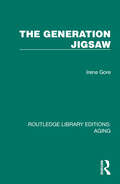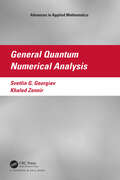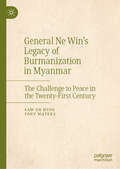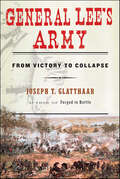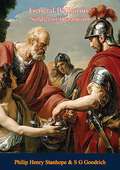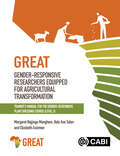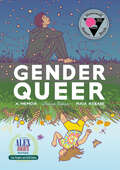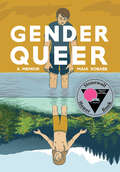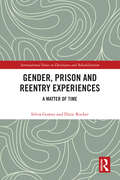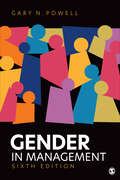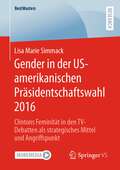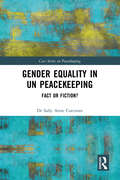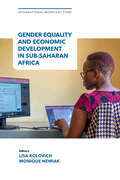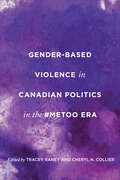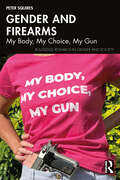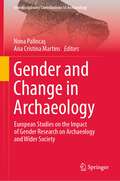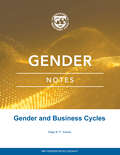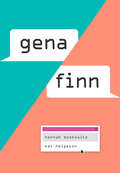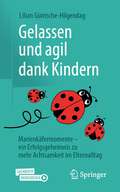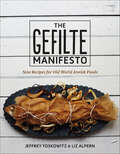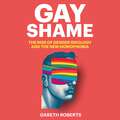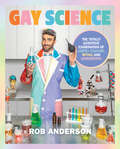- Table View
- List View
The Generation Jigsaw (Routledge Library Editions: Aging)
by Irene GoreIn The Generation Jigsaw, originally published in 1976, Irene Gore explores some of the problems which face older people in the family and the community. Her attitude, differing from many attitudes and practices at the time, was that people in old age are capable of expanding their interests and activities, given encouragement and opportunity.Dr Gore is specifically not concerned with ill people, invalids or the severely disadvantaged. ‘It is my conviction’, she writes, ‘that the problems of the reasonably fit, reasonably independent majority of older people deserve to be considered … The injunction to honour one’s father and mother is part of our ethic, and we traditionally interpret this as “taking care” of them. But “taking care” of older people carries the risk of making them too passive and dependent, of blurring their individuality.’ Whereas in former times a person had a position to look forward to in later years – the regard of the family and the community and the status that experience gave – now the tendency is to channel and guide our elders into a mode of life which someone else thinks is best for them.Dr Gore points the way forward to a livelier, more fulfilled community of people of all ages. She has a scientifically trained mind capable of seeing to the core of the problem, and a genuine concern for the true welfare of older people – and of their younger relatives who will become old in their turn. She approaches her subject with lucidity and an unsentimental humanity, based on years of research on the biological aspects of ageing and hard thinking about the personal and social problems encountered by the elderly. She dispels myths and suggests commonsense solutions and guidelines for improving the quality of life for us all.
General Quantum Numerical Analysis (ISSN)
by Svetlin G. Georgiev Khaled ZennirThis book is focused on the qualitative theory of general quantum calculus, the modern name for the investigation of calculus without limits. It centers on designing, analysing and applying computational techniques for general quantum differential equations. The quantum calculus or q-calculus began with F.H. Jackson in the early twentieth century, but this kind of calculus had already been worked out by Euler and Jacobi. Recently, it has aroused interest due to high demand of mathematics that models quantum computing and the connection between mathematics and physics.Quantum calculus has many applications in different mathematical areas such as number theory, combinatorics, orthogonal polynomials, basic hyper-geometric functions and other sciences such as quantum theory, mechanics and the theory of relativity.The authors summarize the most recent contributions in this area. General Quantum Numerical Analysis is intended for senior undergraduate students and beginning graduate students of engineering and science courses. The twelve chapters in this book are pedagogically organized, each concluding with a section of practical problems.
General Ne Win’s Legacy of Burmanization in Myanmar: The Challenge to Peace in the Twenty-First Century
by Saw Eh Htoo Tony WatersThis book focuses on how Burmanization created and reinforced ethnic divides since the 1962 coup d’etat. when General Ne Win concentrated all authority in the Burmese speaking army. Background research for the book includes Burmese language materials from the Burmese Socialist Party (BSP) and others that describe with what the BSP believed in their own terms. This is unique from previous works on the topic which either simply pointed out that the policies “didn’t work” and therefore are uninteresting, or to claim that they were “necessary” given the chaos of the previous regime. The authors agree that Ne Win’s policies “didn’t work.” However, the book goes further by elaborating why Burmanization policies developed in the 1960s are important for understanding Burmese society today. Most importantly, Ne Win’s ideology reflects how patterns of interethnic relationships in Myanmar lead to the “intractability” of the battles in early twenty-first century Myanmar.
General Lee's Army: From Victory to Collapse
by Joseph Glatthaar"You would be surprised to see what men we have in the ranks," Virginia cavalryman Thomas Rowland informed his mother in May 1861, just after joining the Army of Northern Virginia. His army -- General Robert E. Lee's army -- was a surprise to almost everyone: With daring early victories and an invasion into the North, they nearly managed to convince the North to give up the fight. Even in 1865, facing certain defeat after the loss of 30,000 men, a Louisiana private fighting in Lee's army still had hope. "I must not despair," he scribbled in his diary. "Lee will bring order out of chaos, and with the help of our Heavenly Father, all will be well." Astonishingly, after 150 years of scholarship, there are still some major surprises about the Army of Northern Virginia. In General Lee's Army, renowned historian Joseph T. Glatthaar draws on an impressive range of sources assembled over two decades -- from letters and diaries, to official war records, to a new, definitive database of statistics -- to rewrite the history of the Civil War's most important army and, indeed, of the war itself. Glatthaar takes readers from the home front to the heart of the most famous battles of the war: Manassas, the Peninsula campaign, Antietam, Gettysburg, all the way to the final surrender at Appomattox. General Lee's Army penetrates headquarters tents and winter shanties, eliciting the officers' plans, wishes, and prayers; it portrays a world of life, death, healing, and hardship; it investigates the South's commitment to the war and its gradual erosion; and it depicts and analyzes Lee's men in triumph and defeat. The history of Lee's army is a powerful lens on the entire war. The fate of Lee's army explains why the South almost won -- and why it lost. The story of his men -- their reasons for fighting, their cohesion, mounting casualties, diseases, supply problems, and discipline problems -- tells it all. Glatthaar's definitive account settles many historical arguments. The Rebels were fighting above all to defend slavery. More than half of Lee's men were killed, wounded, or captured -- a staggering statistic. Their leader, Robert E. Lee, though far from perfect, held an exalted place in his men's eyes despite a number of mistakes and despite a range of problems among some of his key lieutenants. General Lee's Army is a masterpiece of scholarship and vivid storytelling, narrated as much as possible in the words of the enlisted men and their officers.
General Belisarius (Philip Henry Stanhope): With a Short Biography of Belisarius by S. G. Goodrich
by Philip Henry Stanhope S G Goodrich“The military commander known as 'the last of the Romans'Flavius Belisarius is a name well known to those interested in the conflicts of the later Roman Empire at the time of Justinian I. The Roman Empire of the west had fallen and the emperor of Byzantine Empire in the east, centred on Constantinople, dreamed of recovering by conquest the Mediterranean territories that had been lost. The ambition was a colossal one, but Belisarius was undoubtedly the military commander for the task. Having won his first laurels against the Persians, he went on to fight the Vandals and Ostrogoths, and eventually captured Rome itself. At the time of his death in 565 AD the empire he served had expanded its territory by almost half.”-Print ed.
Gender-responsive Researchers Equipped for Agricultural Transformation, Level 2.: Trainer’s Manual for the Gender-Responsive Plant Breeding Course
by Dr Margaret Najjingo Mangheni Professor Hale Ann Tufan Dr Elizabeth AsiimweThis manual presents the training process for the Gender-Responsive Plant Breeding course, implemented by Makerere and Cornell Universities, over a period of five years (2016-2020), under the Gender-Responsive Researchers Equipped for Agricultural Transformation (GREAT) project funded by the Bill and Melinda Gates Foundation. It has five broad parts: I) Introduction; II) Required preparation before the course; III) Phase one (9-day, face-to-face training); IV) the 5-month Field Training phase; and V) Phase two (5-day, face-to-face training). Each session consists of specific learning objectives, session plans and slides, delivery methods, practical exercises and examples, as well as relevant tips and synthesized take-home messages. The sessions were developed by an international multidisciplinary team of experts in gender and agriculture and subjected to a rigorous peer review and quality assurance process. GREAT aims to contribute to building a pool of gender-responsive agricultural researchers able to advance more equitable and effective agricultural systems in Africa and beyond. This manual is for all facilitators/trainers interested in applied, gender responsive agricultural research.
Gender Queer: A Memoir Deluxe Edition (Gender Queer)
by Maia KobabeIn 2014, Maia Kobabe, who uses e/em/eir pronouns, thought that a comic of reading statistics would be the last autobiographical comic e would ever write. At the time, it was the only thing e felt comfortable with strangers knowing about em. Then e created Gender Queer. Maia’s intensely cathartic autobiography charts eir journey of self-identity, which includes the mortification and confusion of adolescent crushes, grappling with how to come out to family and society, bonding with friends over erotic gay fan fiction, and facing the trauma and fundamental violation of pap smears. Started as a way to explain to eir family what it means to be nonbinary and asexual, Gender Queer is more than a personal story: It is a useful and touching guide on gender identity—what it means and how to think about it—for advocates, friends, and humans everywhere. This special deluxe hardcover edition of Gender Queer features a brand-new cover, exclusive art and sketches, a foreword from ND Stevenson, Lumberjanes writer and creator of She-Ra and the Princesses of Power, and an afterword from Maia Kobabe.
Gender Queer: A Memoir (Gender Queer Ser.)
by Maia KobabeIn 2014, Maia Kobabe, who uses e/em/eir pronouns, thought that a comic of reading statistics would be the last autobiographical comic e would ever write. At the time, it was the only thing e felt comfortable with strangers knowing about em. Now, Gender Queer is here. Maia’s intensely cathartic autobiography charts eir journey of self-identity, which includes the mortification and confusion of adolescent crushes, grappling with how to come out to family and society, bonding with friends over erotic gay fanfiction, and facing the trauma and fundamental violation of pap smears. Started as a way to explain to eir family what it means to be nonbinary and asexual, Gender Queer is more than a personal story: it is a useful and touching guide on gender identity—what it means and how to think about it—for advocates, friends, and humans everywhere.
Gender, Prison and Reentry Experiences: A Matter of Time (International Series on Desistance and Rehabilitation)
by Silvia Gomes Dixie RockerThis book explores the unique reentry experiences of incarcerated men and women who are about to be released from prisons in Portugal. By analysing gendered reentry experiences through the narratives of men and women, Gender, Prison and Reentry Experiences sheds light on current practices and strategies adopted in prisons regarding reentry and examines the structural, institutional, and personal barriers that infl uence the reentry outcome.Gender, Prison and Reentry Experiences examines the narratives built around an individual’s prison experiences, their perception of the prison’s impact on reentry, and their expectations after release. It reveals how men and women narrate and attribute meaning to their time in prison and how they navigate their ‘prisoner’ and ‘gendered’ identities. In doing so, this book demonstrates the importance of these identities in relation to recidivism and desistance, while also questioning the role incarceration has in further criminalising and obstructing an individual’s reentry process. It puts forward recommendations that aim to improve the lives of all incarcerated individuals within the current system, in addition to advocating for decarceration and prison abolition. It presents a novel contribution to the internationalisation of knowledge across multiple disciplinary subfi elds, namely critical reentry studies and feminist criminology, fi lling a gap in the current knowledge as few studies focus on prison experiences as a core aspect of understanding the reentry process.An accessible and compelling read, this book will appeal to students and scholars of criminology, sociology, law, desistance studies, and those interested in gaining a unique insight into the experience of incarcerated individuals.
Gender in Management
by Gary N. PowellIn the Sixth Edition of Gender in Management, author Gary N. Powell provides a comprehensive survey and review of the literature on sex, gender, and organizations. With the title change from Women and Men in Management to Gender in Management, the new edition adopts a more inclusive lens that acknowledges the diverse identities and experiences within the gender spectrum. Fully updated sections on intersectionality, public events such as COVID-19 and the Black Lives Matter movement, and the prevalence of AI in hiring decisions provide context to the evolving nature of gender in the workplace and society. Powell provides specific research-based strategies for promoting an organizational culture of nondiscrimination, diversity, and inclusion.
Gender in Management
by Gary N. PowellIn the Sixth Edition of Gender in Management, author Gary N. Powell provides a comprehensive survey and review of the literature on sex, gender, and organizations. With the title change from Women and Men in Management to Gender in Management, the new edition adopts a more inclusive lens that acknowledges the diverse identities and experiences within the gender spectrum. Fully updated sections on intersectionality, public events such as COVID-19 and the Black Lives Matter movement, and the prevalence of AI in hiring decisions provide context to the evolving nature of gender in the workplace and society. Powell provides specific research-based strategies for promoting an organizational culture of nondiscrimination, diversity, and inclusion.
Gender in der US-amerikanischen Präsidentschaftswahl 2016: Clintons Feminität in den TV-Debatten als strategisches Mittel und Angriffspunkt (BestMasters)
by Lisa Marie SimmackIn einer stark männlich geprägten US-amerikanischen Politik trat Hillary Clinton 2016 als erste aussichtsreiche weibliche Präsidentschaftskandidatin an. Ihr Gegenkandidat Donald Trump nahm dies zum Anlass, im Wahlkampf wiederholt mit diffamierenden, oft sexistischen Kommentaren auf sich aufmerksam zu machen. Gender und konkret Hillary Clintons Feminität rückten damit in den Vordergrund des polarisierenden und feindseligen Wahlkampfes. Clinton stand in drei TV-Duellen ihrem Kontrahenten gegenüber und versuchte, die Bürger*innen von ihren Kompetenzen als Frau für das höchste politische Amt der USA zu überzeugen. Studien zu Wahlverhalten zeigen, dass die Entscheidung der Wähler*innen am Tag der Wahl nicht bloß davon abhängt, welche Argumente und Positionen die Politiker*innen in den Debatten anführen und vertreten. TV-Duelle nehmen verstärkt eine zentrale Rolle für den Ausgang der Wahlen ein. Dieses Buch analysiert den Genderaspekt (konkret Clintons Feminität) in den drei TV-Debatten und untersucht, inwiefern Clintons Weiblichkeit von Trump als Nachteil dargestellt, von Clinton selbst jedoch als Vorteil genutzt wurde, um rhetorisch zu punkten. Hierzu werden die Debatten- und Kommunikationsstrategien der beiden Politiker*innen systematisch analysiert.
Gender Equality in UN Peacekeeping: Fact or Fiction? (ISSN)
by Sally Anne CorcoranThis book investigates to what extent UNSCR 1325/WPS agenda has functioned in practice, to advance women’s equality and empowerment in the peacekeeping context and beyond.The book examines whether widespread implementation of UNSCR 1325 and the broader WPS agenda via gender mainstreaming in UN operations has translated into increased gender equality in peacekeeping operations, the broader UN institutional context and, by extension, the host countries in which missions are situated, via norm dissemination. The book investigates this via a review of the implementation of UNSCR1325 in the operations chosen as research sites over three snapshot years. The book undertakes a comparative analysis that scrutinizes if, how and under what conditions gender mainstreaming has succeeded as a strategy to advance gender equality by analyzing the factors/conditions that have led to successful gender mainstreaming across the operational context, and those that have impeded this outcome. The book concludes that, despite rhetorical commitments to women’s equality in peacekeeping since the passage of UNSCR 1325, progress on the ground has remained minimal, and that the operational environment continues to be discriminatory against women. Both quantitatively and qualitatively, women do not participate as equal partners in peacekeeping and continue to have less access to resources and decision-making power, overall. The book interrogates that by exploring the spaces available within law, policy and practice of the UN to pursue the human rights agenda of gender equality and considers whether UNSCR 1325 has enlarged those spaces. It also points to the irony of internal UN structures failing to adequately adapt to their own gender mainstreaming mandates, while those same structures have delivered some gender equality mandates successes externally, at local levels.This book will be of interest to students of peacekeeping, gender studies, and International Relations.
Gender Equality and Economic Development in Sub-Saharan Africa: [subtitle]
by Gaston Gelos, Ratna SahayA report from the International Monetary Fund.
Gender-Based Violence in Canadian Politics in the #MeToo Era
by Tracey Raney Cheryl N. CollierGender-based violence in politics is a significant and growing problem that threatens the democratic process in Canada. Despite its prevalence, little academic research has been conducted on this topic to date. Gender-Based Violence in Canadian Politics in the #MeToo Era raises awareness of and presents new innovative research on this timely and pressing public issue. Here, leading experts from across Canada uncover critical new insights and identify potential solutions that would help address gender-based violence in politics, improve gender equality, and strengthen Canadian democracy. Using an intersectional lens, chapters range in their approaches; offer new concepts and measures of gender-based violence in online political spaces, political media coverage and cartoons, campaigns, municipal politics, and legislatures; and explore Indigenous ways of knowing about gender-based violence in Canadian politics. Additionally, the volume presents recommendations for decision-makers, policymakers, anti-violence advocates, and the academic community on how to best address the problem of gender-based violence in the political sphere.
Gender and Firearms: My Body, My Choice, My Gun (Routledge Research in Gender and Society)
by Peter SquiresPrivate gun ownership for self-defense remains a major personal and public issue in the United States, driven by concerns about crime, vulnerability and a range of ‘ideological’ factors, including race and gender. As media attention centres upon the extent to which women are taking up firearms, with the gun lobby and firearms manufacturers celebrating the ‘new armed woman’, and guns being promoted as ‘Rape Prevention Kits’, this book explores the changing gendered aspects of gun ownership.Can ownership of firearms by women be considered, as some have claimed, the embodiment of what might be termed ‘pioneer feminism’, as women resist male violence in a dangerous world, or are different stories told by the prominence of women in firearms control campaigns, or the fact that women remain frequent victims of male gun ownership? Analysing representations of the ‘armed woman’ in firearm and gun lobby marketing and advertising campaigns, together with television and popular music forms, Gender and Firearms: My Body, My Choice, My Gun examines the directions taken in the public debate on weaponisation in the United States, considering the role of women in the politics of gun safety and gun control. The book draws on statistical evidence in order to shed light on trends in gun ownership, whilst engaging with feminist scholarship on the relationship between gender, violence, risk and vulnerabilities, thus opening up critical new debates surrounding identity, performance, gender and risk in contemporary societies.As such the book will be of likely interest to sociologists and scholars of sociology, criminology, and cultural and media studies with interests in gender, embodiment, risk, crime and violence.
Gender and Change in Archaeology: European Studies on the Impact of Gender Research on Archaeology and Wider Society (Interdisciplinary Contributions to Archaeology)
by Nona Palincaş Ana Cristina MartinsThis volume presents the various ways in which the study of gender makes a difference in archaeological research, the archaeological academic milieu and the wider public’s thinking about gender and considers avenues of future development. It addresses questions such as why gender matters for archaeology, while examining gender from various angles (including aspects such as subjectivity, embodiment, diet, multifaceted perspectives and intersectionality) and in various periods (prehistory, Ancient Egypt, Roman antiquity, the Middle Ages and the modern and contemporary periods). It also discusses the relationship between archaeology and other academic fields involving the study of gender, as well as representations and debates on gender in the media. The theme ‘gender and change in archeology’ emerged out of concerns voiced within the ‘Archaeology and Gender in Europe’ (AGE) working community of the European Association of Archaeologists (EAA) with respect to thefuture of gender archaeology. This book unites researchers of gender archaeology from two perspectives: that of gender archaeologists from academic milieus where the study of gender has long been established and who in the meantime came to feel that this avenue of inquiry had become predictable and lost its provocative power, and that of gender archaeologists from countries where this field was only recently introduced and who, while more enthusiastic about the utility of gender archaeology, are concerned with how to disseminate it among skeptical peers. Both groups of archaeologists mainly argue that, four decades on, the study of gender in archaeology is still able to generate considerable change in our understanding of past and present-day societies. The volume is primarily of interest to archaeologists and researchers of gender studies.
Gena/Finn
by Hannah Moskowitz Kat HelgesonGena and Finn would have never met but for their mutual love for the popular show Up Below. Regardless of their differences—Gena is a recent high school graduate whose social life largely takes place online, while Finn is in her early twenties, job hunting and contemplating marriage with her longtime boyfriend—the two girls realize that the bond between them transcends fanfiction. When disaster strikes and Gena's world turns upside down, only Finn can save her, and that, too, comes with a price. Told through emails, text messages, journal entries, and blog posts, Gena/Finn is a story of friendship and love in the digital age.
Geld, Generation und Ungleichheit: Finanzielle Solidarität zwischen Erwachsenen und ihren Eltern
by Tamara BosshardtDas vorliegende Open-Access-Buch analysiert finanzielle Transfers zwischen Erwachsenen und ihren Eltern, die zur Reproduktion von Ungleichheiten auf der Makroebene beitragen. Soziale Ungleichheiten in der Kindergeneration lassen sich zu einem grossen Teil auf soziale Ungleichheiten in der Elterngeneration zurückführen. Genauer geht die Autorin den Fragen nach, wer mehr bzw. weniger Geld-, Sachgeschenke oder Zahlungen leistet und erhält, welche Faktoren Unterschiede im Transferverhalten erklären und wie sich finanzielle Transfers zwischen Generationen auf Ungleichheitsstrukturen in der Kindergeneration auswirken. Die theoretische Perspektive kombiniert Ansätze aus der Ungleichheits- und Familiensoziologie mit Theorien zur Erklärung von solidarischem Handeln und kumulativen Prozessen. Ob und in welchem Umfang sich Erwachsene und ihre Eltern gegenseitig unterstützen können, hängt stark von ihren jeweiligen ökonomischen Ressourcen ab. Auf gesellschaftlicher Ebene bedeutet lebenslange familiale Solidarität daher häufig lebenslange Ungleichheit von Unterstützungsstrukturen. Finanzielle Transfers zwischen Familiengenerationen reduzieren damit zwar Ungleichheiten innerhalb von Familien, tragen insgesamt aber zu einer Verschärfung der Ungleichheiten zwischen Familien bei.
Gelassen und agil dank Kindern: Marienkäfermomente - ein Erfolgsgeheimnis zu mehr Achtsamkeit im Elternalltag
by Lilian Güntsche-HilgendagWelche einzigartige Chance erhalten wir durch Kinder? Durch Kinder lernen wir Dinge wieder bewusster wahrzunehmen, sind achtsamer. Wir erleben unser Leben noch einmal – aus Kinderaugen. Oder anders gesagt: „Es wird auf einmal wieder wichtig, wie viele Punkte ein Marienkäfer hat.“Viele Eltern fühlen sich gestresst und kommen hin und wieder an die eigenen Grenzen. Wie uns sogenannte „Marienkäfermomente“ dabei unterstützen können gelassener zu werden, erklärt dieses Buch. Es liefert einen innovativen Mix aus den Grundhaltungen der Achtsamkeit und Agilität, angewandt auf den Elternalltag.Zahlreiche Tipps, auch in audio-visueller Form, sowie die anknüpfende Gesprächsreihe „Achtsamkeit für Eltern“ liefern Impulse für mehr Gelassenheit und zeigen kreative Wege für eine gelingende Vereinbarkeit von Berufs- und Familienleben.
The Gefilte Manifesto: New Recipes for Old World Jewish Foods
by Jeffrey Yoskowitz Liz AlpernThe founders of the world-famous Gefilteria revitalize beloved old-world foods with ingenious new approaches in their debut cookbook, The Gefilte Manifesto.Liz Alpern and Jeffrey Yoskowitz are on a mission to reclaim and revolutionize Ashkenazi cuisine. Combining the inventive spirit of a new generation and respect for their culinary tradition, they present more than a hundred recipes pulled deep from the kitchens of Eastern Europe and the diaspora community of North America. Their recipes highlight the best of Ashkenazi home and storefront cuisine, tapping into the enduring Jewish values of resourcefulness and seasonality.Drawing inspiration from aromatic Jewish bakeries (Classic Challah with a Marble Rye Twist, Seeded Honey Rye Pull-Apart Rolls), neighborhood delis (Home-Cured Corned Beef and Pastrami, Rustic Matzo Balls, and Old World Stuffed Gefilte Fish), old-fashioned pickle shops (Crisp Garlic Dilly Beans, Ashkenazi Kimchi), and, of course, their own childhood kitchens, Yoskowitz and Alpern rediscover old-world food traditions, helping you bring simple and comforting recipes into your home.Dishes like Spiced Blueberry Soup, Kasha Varnishkes with Brussels Sprouts, and Sweet Lokshen Kugel with Plums celebrate flavors passed down from generation to generation in recipes reimagined for the contemporary kitchen. Other recipes take a playful approach to the Old World, like Fried Sour Pickles with Garlic Aioli and Sour Dill Martinis.The Gefilte Manifesto is more than a cookbook. It’s a call to action, a reclamation of time-honored techniques and ingredients, from the mind-blowingly easy Classic Sour Dill Pickles to the Crispy Honey-Glazed Chicken with Tsimmes. Make a stand. Cook the Manifesto. The results are radically delicious.
Gebäudeautomation in Wohn- und Wirtschaftsimmobilien: Energetische Einsparpotenziale durch Gebäudeautomation (Studien zum nachhaltigen Bauen und Wirtschaften)
by Giulio Saric Thomas GlatteMit Gebäudeautomation lassen sich Komfort und Sicherheit eines Gebäudes steigern. Dazu kommt das Potenzial, die Energieeffizienz der Immobilie zu erhöhen, was wirschaftliche Vorteile bei der Bewirtschaftung mit sich bringt. Diese Publikation untersucht verschiedene Smart-Home Technologien im Hinblick auf die Senkung der Energiekosten und vergleicht den ökonomischen Nutzen zwischen Wirtschafts- und Wohnimmobilien. Dabei werden die Anwendungsfelder Beleuchtung, Klimatisierung und Beschattung analysiert und bewertet.
Gay Shame: The Rise of Gender Ideology and the New Homophobia
by Gareth RobertsOnly a few years ago, it seemed that the fight for gay rights was won in the UK: legal equality was achieved, prejudice rapidly dying out. Mission accomplished, right?Wrong, argues Gareth Roberts. Homophobia is making a major comeback under the guise of the ideology of 'gender identity'. The enforcers of this new creed insist that attraction to people of the same sex is 'hateful'. They argue that effeminate men and butch women can't just be gay, but must 'really' be trans. Worse, this ideology has colonised the gay rights movement, capturing institutions like Stonewall and the gay press completely. Anyone who disagrees risks professional suicide.So what happened to the funny, grown-up culture, truth-telling and knowing irony of gay men? How and why was the older gay rights activism, which gifted such progress to homosexual people, hijacked?In this passionate, witty polemic, Gareth Roberts answers these questions and argues that we need a new gay liberation movement.
Gay Science: The Totally Scientific Examination of LGBTQ+ Culture, Myths, and Stereotypes
by Rob AndersonComedian Rob Anderson examines queer stereotypes and LGBTQ+ culture with humorous explanations borrowed from real principles across multiple fields of science.Class is in session, babe! Discover the inner workings of the LGBTQ+ community with this humorous and informative book. Author and comedian Rob Anderson borrows the familiar science textbook format to skewer ridiculous queer stereotypes with his own version of science.Using the principles of natural, social, and formal sciences, Rob answers extremely serious questions like: Why can&’t gays sit in a chair properly? Why don&’t lesbians have electricity in their movies? Are colleges turning people bisexual? How does gaydar work? Will bottoms survive the apocalypse? You&’ll read about the three subtypes of the gay uncle species, examine the Periodic Table of LGBTQ+ Elements, understand gay crime and punishment, and get educated on the types of bacteria and viruses that exclusively affect the LGBTQs, like the state of Florida.Inspired by his viral &“Gay Science&” series, Rob recreates some of his most popular episodes in a literary format, and also tackles completely fresh subjects, presenting them with super empirical and totally evidence-based homosexual data.Gay Science includes:Coverage of 60 topics across 29 fields of science including biology, chemistry, physics, genetics, botany, nutrition, astronomy, anthropology, oceanography, sociology, criminology, engineering, computer science, and more!Informative sidebars including Get PrePared, The Tea, Serving Conclusions, The Gloss, Yas or Naur, Fagtoids, and A Lesbian Explains.Diagrams, charts, illustrations, and maps to explain the gayest concepts.Rob Anderson is course-correcting decades of educational shortcomings by explaining the scientific reasonings behind every aspect of LGBTQ+ life. If you&’re looking for a fun book that will probably be banned (if it isn&’t already), add Gay Science to your personal lesson plan.
